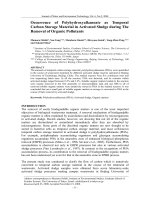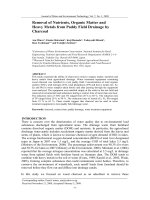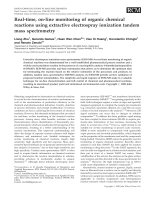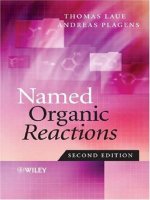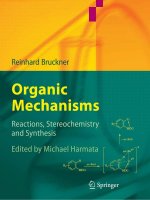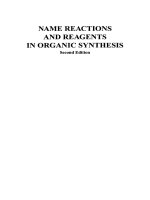Organic name reactions
Bạn đang xem bản rút gọn của tài liệu. Xem và tải ngay bản đầy đủ của tài liệu tại đây (11.41 MB, 450 trang )
This document is created with trial version of CHM2PDF Pilot 2.16.100.
Organic Name Reactions
The Organic Name Reactions (ONR) section is intended to serve the professional chemist and student by describing organic
chemical reactions which have come to be recognized and referred to by name within the chemistry community. A select
group has been chosen for addition to this section. Each reaction description is designed to be informative and representative
of the pertinent literature; however, it is not meant to be comprehensive. The descriptions are composed of the following: (1)
name(s) associated with the reaction, (2) the original and/or primary contributor(s) connected with the discovery and/or
development of the reaction, (3) a concise description of the transformation, (4) a reaction scheme, (5) key references, and
(6) cross references to other ONR based on commonalities. The index included in this section also lists supplementary terms.
Abbreviations
Ac
acetyl
E
electrophile
Ar
aryl
ee
enantiomeric excess
aq
aqueous
Et
ethyl
B
base
EtOH
ethanol
BBN
borabicyclo[3.3.1]nonane
EWG
electron withdrawing group
HA
protic acid
BINAP 2,2'-bis(diphenylphosphino)-1,1'-binaphthyl
BOC
t-butyloxycarbonyl
HMPT hexamethylphosphoric triamide
Bu
butyl
LDA
cat
catalytic
LHMDS lithium hexamethyldisilazide
Cp
cyclopentyldienide
Me
methyl
Δ
heat
NuH
nucleophile
dba
dibenzylideneacetone
Ph
phenyl
DCC
dicyclohexylcarbodiimide
Pr
propyl
DEAD diethylazadicarboxylate
salen
N,N'-ethylenebis(salicylideneimine)
DME
dimethylether
Tf
trifluoromethanesulfonyl
dppf
dichloro[1,1'-bis(diphenylphosphino)ferrocene] Ts
dppp
1,3-bis(diphenylphosphino)propane
lithium diisopropylamide
p-toluenesulfonyl
Copyright © 2001 by Merck & Co., Inc., Whitehouse Station, NJ, USA. All rights reserved.
Electronic Edition Copyright © 2001 by CambridgeSoft Corp., Cambridge, MA, USA. All rights reserved.
This document is created with trial version of CHM2PDF Pilot 2.16.100.
403. Ugi Reaction (Four-Component Condensation, 4CC)
I. Ugi, Angew. Chem. Int. Ed. 1, 8 (1962).
The α-addition of an iminium ion and the conjugate base of a carboxylic acid to an isocyanide, followed by
spontaneous rearrangement of the α-adduct to yield an α-aminocarboxamide derivative. Carbonyl compounds and
amines, or their condensation products, serve as precursors to the iminium ion. The nature of the product depends
primarily on the acid component:
When four discrete reactants are used, the reaction is often referred to as the four-component condensation
(4CC). Diastereoselective methods development: H. Kunz et al., Synthesis 1991, 1039; M. Goebel, I. Ugi, ibid.
1095. Synthetic applications: T. Ziegler et al., Tetrahedron Letters 39, 5957 (1998); eidem, Tetrahedron 55, 8397
(1999). Reviews: I. Ugi, Proc. Estonian Acad. Sci. Chem. 40, 1-13 (1991); I. Ugi et al., Comp. Org. Syn. 2,
1083-1109 (1991).
Copyright © 2001 by Merck & Co., Inc., Whitehouse Station, NJ, USA. All rights reserved.
This document is created with trial version of CHM2PDF Pilot 2.16.100.
76. Claisen Condensation (Acetoacetic Ester Condensation)
L. Claisen, O. Lowman, Ber. 20, 651 (1887).
Base-catalyzed condensation of an ester containing an α-hydrogen atom with a molecule of the same ester or a
different one to give β-keto esters:
C. R. Hauser, B. E. Hudson, Org. React. 1, 266-322 (1942); H. O. House, Modern Synthetic Reactions (W. A.
Benjamin, Menlo Park, California, 2nd ed., 1972) pp 734-746; J. F. Garst, J. Chem. Ed. 56, 721 (1979); J. E.
Bartmess et al., J. Am. Chem. Soc. 103, 1338 (1981); B. R. Davis, P. J. Garratt, Comp. Org. Syn. 2, 795-805
(1991). Cf. Dieckmann Reaction .
Copyright © 2001 by Merck & Co., Inc., Whitehouse Station, NJ, USA. All rights reserved.
This document is created with trial version of CHM2PDF Pilot 2.16.100.
1. Acetoacetic Ester Synthesis
Base-catalyzed alkylation or arylation of β-ketoesters. Subsequent mild hydrolysis and decarboxylation yield
substituted acetones. Alternately, treatment with concentrated base produces substituted esters:
Synthetic applications: R. Kluger, M. Brandl, J. Org. Chem. 51, 3964 (1986); T. Yamamitsu et al., J. Chem. Soc.
Perkin Trans. I 1989, 1811.
Copyright © 2001 by Merck & Co., Inc., Whitehouse Station, NJ, USA. All rights reserved.
This document is created with trial version of CHM2PDF Pilot 2.16.100.
2. Acyloin Condensation
L. Bouveault, R. Loquin, Compt. Rend. 140, 1593 (1905).
Reductive coupling of esters by sodium to yield acyloins (α-hydroxyketones). Yields are greatly improved in the
presence of trimethylchlorosilane:
K. T. Finley, Chem. Rev. 64, 573 (1964); K. Ziegler, Houben-Weyl 4/2, 729-822 (1955); S. M. McElvain, Org.
React. 4, 256 (1948); J. J. Bloomfield et al., ibid. 23, 259 (1976); R. Brettle, Comp. Org. Syn. 3, 613-632 (1991).
Cf. Benzoin Condensation.
Copyright © 2001 by Merck & Co., Inc., Whitehouse Station, NJ, USA. All rights reserved.
This document is created with trial version of CHM2PDF Pilot 2.16.100.
258. Michael Reaction (Addition, Condensation)
A. Michael, J. Prakt. Chem. [2] 35, 349 (1887).
Base-promoted conjugate addition of carbon nucleophiles (donors) to activated unsaturated systems (acceptors):
Reviews: E. D. Bergmann et al., Org. React. 10, 179-555 (1959); H. O. House, Modern Synthetic Reactions
(W. A. Benjamin, Menlo Park, California, 2nd ed., 1972) pp 595-623; M. E. Jung, Comp. Org. Syn. 4, 1-67
(1991). Review of organometallic nucleophiles: D. A. Hunt et al., Org. Prep. Proced. Int. 21, 705-749 (1989); V.
J. Lee, Comp. Org. Syn. 4, 69-137, 139-168 (1991); J. A. Kozlowski, ibid. 169-198. Reviews of stereoselective
synthesis: H.-G. Schmalz, ibid. 199-236; D. A. Oare, C. H. Heathcock, Top. Stereochem. 20, 87-170 (1991); J.
d'Angelo et al., Tetrahedron Asymmetry 3, 459-505 (1992); J. Leonard et al., Eur. J. Org. Chem. 1998, 20512061. Cf. Nagata Hydrocyanation ; Robinson Annulation.
Copyright © 2001 by Merck & Co., Inc., Whitehouse Station, NJ, USA. All rights reserved.
This document is created with trial version of CHM2PDF Pilot 2.16.100.
3. Akabori Amino Acid Reactions
S. Akabori, J. Chem. Soc. Japan 52, 606 (1931); Ber. 66, 143, 151 (1933); J. Chem. Soc. 64, 608 (1943).
1. Formation of aldehydes by oxidative decomposition of α-amino acids when heated with sugars according to the
equation:
2. Reduction of α-amino acids and esters by sodium amalgam and ethanolic hydrogen chloride to the corresponding
α-amino aldehydes:
3. Formation of alkamines by heating mixtures of aromatic aldehydes and amino acids. No reaction was observed
with tertiary amino groups.
E. Takagi et al., J. Pharm. Soc. Japan 71, 648 (1951); 72, 812 (1952); A. Lawson, H. V. Morley, J. Chem. Soc.
1955, 1695; A. Lawson, ibid. 1956, 307; K. Dose, Ber. 90, 1251 (1957); V. N. Belikov et al., Izv. Akad. Nauk
SSSR, Ser. Khim. 1969, 2536.
Copyright © 2001 by Merck & Co., Inc., Whitehouse Station, NJ, USA. All rights reserved.
This document is created with trial version of CHM2PDF Pilot 2.16.100.
102. Diels-Alder Reaction
O. Diels, K. Alder, Ann. 460, 98 (1928); 470, 62 (1929); Ber. 62, 2081, 2087 (1929).
The 1,4-addition of the double bond of a dienophile to a conjugated diene to generate a six-membered ring, such
that up to four new stereocenters may be created simultaneously. The [4+2]-cycloaddition usually occurs with high
regio- and stereoselectivity:
Heteroatomic analogs of the diene (e.g., CHR=CR-CR=O, O=CR-CR=O, and RN=CR-CR=NR) and
dienophile (e.g., RN=NR, R2C=NR, and RN=O) may also serve as reactants.
Early reviews: M. C. Kloetzel, Org. React. 4, 1-59 (1948); H. L. Holmes ibid. 60-173; L. W. Butz, A. W.
Rytina, ibid. 5, 136-192 (1949). Intermolecular reactions: W. Oppolzer, Comp. Org. Syn. 5, 315-399 (1991).
Intramolecular reactions: E. Ciganek, Org. React. 32, 1-374 (1984); W. R. Rousch, Comp. Org. Syn. 5, 513-550
(1991). Use of heterodienophiles: S. M. Weinreb, ibid. 401-449. Use of nitroso dienophiles: J. Streith, A. DeFoin,
Synthesis 1994, 1107-1117. Use of heterodienes: D. L. Boger, ibid, 451-512. Review of diastereoselectivity: J. M.
Coxon et al., “Diastereofacial Selectivity in the Diels-Alder Reaction” in Advances in Detailed Reaction
Mechanisms 3, 131-166 (1994); T. Oh, M. Reilly, Org. Prep. Proceed. Int. 26, 131-158 (1994); H. Waldmann,
Synthesis 1994, 535-551. Cf. Wagner-Jauregg Reaction.
Copyright © 2001 by Merck & Co., Inc., Whitehouse Station, NJ, USA. All rights reserved.
This document is created with trial version of CHM2PDF Pilot 2.16.100.
120. Ene Reaction (Alder-Ene Reaction); Conia Reaction
K. Alder et al., Ber. 76, 27 (1943).
The addition of an alkene having an allylic hydrogen (ene) to a compound containing a multiple bond (enophile) to
form a new bond between two unsaturated termini, with an allylic shift of the ene double bond, and transfer of the
allylic hydrogen to the enophile. The mechanism is related to that of the Diels-Alder reaction, q.v.:
Lewis acid-promoted cyclization of 5-hexenals: J. A. Marshall, Chemtracts-Org. Chem. 5, 1-7 (1992). Review
of alkenes as enophiles: B. B. Snider, Comp. Org. Syn. 5, 1-27 (1991). Review of carbonyl compounds as
enophiles: idem, ibid. 2, 527-561; in conjunction with asymmetric synthesis: K. Mikami, M. Shimizu, Chem. Rev. 92,
1021-1050 (1992); K. Mikami et al., Synlett 1992, 255-265.
The intramolecular Ene reaction of unsaturated ketones, in which the carbonyl functionality serves as the ene
component, via its tautomer, and the olefinic moiety serves as the enophile, is known as the Conia reaction:
F. Rouessac et al., Tetrahedron Letters 1965, 3319. Review: J. M. Conia, P. Le Perchec, Synthesis 1975, 119.
Copyright © 2001 by Merck & Co., Inc., Whitehouse Station, NJ, USA. All rights reserved.
This document is created with trial version of CHM2PDF Pilot 2.16.100.
4. Aldol Reaction (Condensation)
R. Kane, Ann. Phys. Chem., Ser. 2, 44, 475 (1838); idem, J. Prakt. Chem. 15, 129 (1838).
Traditionally, it is the acid- or base-catalyzed condensation of one carbonyl compound with the enolate/enol of
another, which may or may not be the same, to generate a β-hydroxy carbonyl compound—an aldol. The method is
compromised by self-condensation, polycondensation, generation of regioisomeric enols/enolates, and dehydration of the
aldol followed by Michael addition, q.v. The development of methods for the preparation and use of preformed enolates
or enol derivatives, that dictate specific carbon-carbon bond formation, have revolutionized the coupling of carbonyl
compounds:
Historical perspective: C. H. Heathcock, Comp. Org. Syn. 2, 133-179 (1991). General review: T. Mukaiyama, Org.
React. 28, 203-331 (1982). Application of lithium and magnesium enolates: C. H. Heathcock, Comp. Org. Syn. 2, 181238 (1991); of boron enolates: B. M. Kim et al., ibid. 239-275; of transition metal enolates: I. Paterson, ibid. 301-319.
Stereoselective reactions of ester and thioester enolates: M. Braun, H. Sacha, J. Prakt. Chem. 335, 653-668 (1993).
Review of asymmetric methodology: A. S. Franklin, I. Paterson, Contemp. Org. Syn. 1, 317-338 (1994). Cf. ClaisenSchmidt Condensation; Henry Reaction; Ivanov Reaction; Knoevenagel Condensation; Reformatsky Reaction; Robinson
Annulation.
Copyright © 2001 by Merck & Co., Inc., Whitehouse Station, NJ, USA. All rights reserved.
This document is created with trial version of CHM2PDF Pilot 2.16.100.
5. Algar-Flynn-Oyamada Reaction
J. Algar, J. P. Flynn, Proc. Roy. Irish Acad. 42B, 1 (1934); B. Oyamada, J. Chem. Soc. Japan 55, 1256 (1934).
Alkaline hydrogen peroxide oxidation of o-hydroxyphenyl styryl ketones (chalcones) to flavonols via the intermediate
dihydroflavonols:
T. S. Wheeler, Record Chem. Progr. 18, 133 (1957); W. P. Cullen et al., J. Chem. Soc. C 1971, 2848.
Mechanism: T. R. Gormley, et al., Tetrahedron 29, 369 (1973); M. Bennett et al., ibid. 54, 9911 (1998). Synthetic
applications: H. Wagner et al., ibid. 33, 1405 (1977); A. C. Jain et al., Bull. Chem. Soc. Japan 56, 1267 (1983). Cf.
Auwers Synthesis.
Copyright © 2001 by Merck & Co., Inc., Whitehouse Station, NJ, USA. All rights reserved.
This document is created with trial version of CHM2PDF Pilot 2.16.100.
6. Allan-Robinson Reaction
J. Allan, R. Robinson, J. Chem. Soc. 125, 2192 (1924).
Preparation of flavones or isoflavones by condensing o-hydroxyaryl ketones with anhydrides of aromatic acids and
their sodium salts:
S. F. Dyke et al., J. Org. Chem. 26, 2453 (1961); Seshandri in The Chemistry of Flavonoid Compounds, T. A.
Geissman, Ed. (New York, 1962) p 182; Gripenberg, ibid. p 411; W. Rahman, K. T. Nasim, J. Org. Chem. 27, 4215
(1962); D. L. Dreyer et al., Tetrahedron 20, 2977 (1964). Synthesis applications: P. K. Dutta et al., Indian J. Chem.
21B, 1037 (1982); T. Horie et al., Chem. Pharm. Bull. 37, 1216 (1989); J. K. Makrandi et al., Synth. Commn. 19,
1919 (1989); E. J. Corey et al., Tetrahedron Letters 37, 7162 (1996); B. P. Reddy et al., J. Heterocyclic Chem. 33,
1561 (1996). Cf. Baker-Venkataraman Rearrangement; Kostanecki Acylation.
Copyright © 2001 by Merck & Co., Inc., Whitehouse Station, NJ, USA. All rights reserved.
This document is created with trial version of CHM2PDF Pilot 2.16.100.
7. Allylic Rearrangements
L. Claisen, Ber. 45, 3157 (1912).
Migration of a carbon-carbon double bond in a three carbon (allylic) system on treatment with nucleophiles under
SN1 conditions (or under SN2 conditions when the nucleophilic attack takes place at the γ-carbon):
Reviews: J. R. DeWolfe, W. G. Young, Chem. Rev. 56, 753 (1956); W. G. Young, J. Chem. Ed. 39, 455 (1962);
P. de la Mare in Molecular Rearrangements Part 1, P. de Mayo, Ed. (Wiley-Interscience, New York, 1963) pp 27110; K. Mackenzie in The Chemistry of Alkenes, S. Patai, Ed. (Interscience, New York, 1964) pp 436-453; R. H.
DeWolfe, W. G. Young in ibid. pp 681-738; J. March, Advanced Organic Chemistry (Wiley-Interscience, New
York, 4th ed., 1992) pp 327-330.
Copyright © 2001 by Merck & Co., Inc., Whitehouse Station, NJ, USA. All rights reserved.
This document is created with trial version of CHM2PDF Pilot 2.16.100.
250. Meerwein-Ponndorf-Verley Reduction (Aluminum Alkoxide Reduction)
H. Meerwein, R. Schmidt, Ann. 444, 221 (1925); W. Ponndorf, Angew. Chem. 39, 138 (1926); A. Verley, Bull.
Soc. Chim. France 37, 537, 871 (1925).
Reduction of aldehydes or ketones to the corresponding alcohols with aluminum alkoxides (the reverse of the
Oppenauer oxidation, q.v.):
Reviews: A. L. Wilds, Org. React. 2, 178-202 (1944); R. M. Kellogg, Comp. Org. Syn. 8, 88-91 (1991); C. F.
de Graauw et al., Synthesis 10, 1007-1017 (1994). Enantioselectivity: D. A. Evans et al., J. Am. Chem. Soc. 115,
9800 (1993); M. Node et al., ibid. 122, 1927 (2000). Modified conditions: P. S. Kumbhar et al., Chem.
Commun., 1998, 535; T. Ooi et al., J. Am. Chem. Soc. 120, 10790 (1998); Y. Nakano et al., Tetrahedron
Letters 41, 1565 (2000). Cf. Cannizzaro Reaction ; Tischenko Reaction.
Copyright © 2001 by Merck & Co., Inc., Whitehouse Station, NJ, USA. All rights reserved.
This document is created with trial version of CHM2PDF Pilot 2.16.100.
8. Amadori Rearrangement
M. Amadori, Atti Accad. Nazl. Lincei 2(6), 337 (1925), C.A. 20, 902 (1926); ibid. 9(6), 68, 226 (1929), C.A. 23,
3211, 3443 (1929).
Conversion of N-glycosides of aldoses to N-glycosides of the corresponding ketoses by acid or base catalysis:
J. E. Hodge, Advan. Carbohyd. Chem. 10, 169 (1955); R. U. Lemieux in Molecular Rearrangements Part 2, P.
13
de Mayo, Ed. (Wiley-Interscience, New York, 1964) p 753. C-NMR studies: W. Funcke, Ann. 1978, 2099.
Review: K. Maruoka, H. Yamamoto, Comp. Org. Syn. 6, 789-791 (1991).
Copyright © 2001 by Merck & Co., Inc., Whitehouse Station, NJ, USA. All rights reserved.
This document is created with trial version of CHM2PDF Pilot 2.16.100.
314. Pinner Reaction (Amidine and Ortho Ester Synthesis)
A. Pinner, F. Klein, Ber. 10, 1889 (1877); 11, 4, 1475 (1878); 16, 352, 1643 (1883).
Formation of imino esters (alkyl imidates) by addition of dry hydrogen chloride to a mixture of a nitrile and an
alcohol. Treatment of alkyl imidates with ammonia or primary or secondary amines affords amidines, while treatment
with alcohols yields ortho-esters:
Reviews: R. Roger, D. Neilson, Chem. Rev. 61, 179 (1961); E. N. Zil'berman, Russ. Chem. Rev. 31, 615
(1962); P. L. Compagnon, M. Moeque, Ann. Chim. (Paris) 5, 23 (1970); B. Decroix et al., J. Chem. Res. 1978,
134.
Copyright © 2001 by Merck & Co., Inc., Whitehouse Station, NJ, USA. All rights reserved.
This document is created with trial version of CHM2PDF Pilot 2.16.100.
193. Hofmann-Martius Rearrangement (Aniline Rearrangement)
A. W. Hofmann, C. A. Martius, Ber. 4, 742 (1871); A. W. Hofmann, ibid. 5, 720 (1872).
Thermal conversion of N-alkylaniline hydrohalides to o- and p-alkylanilines:
H. Hart, J. R. Kosak, J. Org. Chem. 27, 116 (1962); Y. Ogata et al., Tetrahedron 20, 2717 (1964); J. Org.
Chem. 35, 1642 (1970); G. F. Grillot in Mechanisms of Molecular Migration vol. 3, B. S. Thyagarajan, Ed.
(Wiley, New York, 1971) p 237; A. G. Giumanini et al., J. Org. Chem. 40, 1677 (1975); W. F. Burgoyne, D. D.
Dixon, J. Mol. Catal. 62, 61 (1990); M. G. Siskos et al., Bull. Soc. Chim. Belg. 105, 759 (1996).
Copyright © 2001 by Merck & Co., Inc., Whitehouse Station, NJ, USA. All rights reserved.
This document is created with trial version of CHM2PDF Pilot 2.16.100.
259. Michaelis-Arbuzov Reaction
A. Michaelis, R. Kaehne, Ber. 31, 1048 (1898); A. E. Arbuzov, J. Russ. Phys. Chem. Soc. 38, 687 (1906); Chem.
Zentr. 1906, II, 1639.
Formation of monoalkylphosphonic esters from alkyl halides and trialkyl phosphites, via the intermediate
phosphonium salt:
K. Sasse, Houben-Weyl 12/1, 433 (1963); B. A. Arbuzov, Pure Appl. Chem. 9, 307 (1964); G. M.
Kosolapoff, Org. React. 6, 276 (1951); D. Redmore, Chem. Rev. 71, 317 (1971); G. Bauer, G. Haegele, Angew.
Chem. Int. Ed. 16, 477 (1977); A. K. Bhattacharya, G. Thyagarajan, Chem. Rev. 81, 415 (1981); B. Faure et al.,
Chem. Commun. 1989, 805; V. K. Yadav, Synth. Commun. 20, 239 (1990).
Copyright © 2001 by Merck & Co., Inc., Whitehouse Station, NJ, USA. All rights reserved.
This document is created with trial version of CHM2PDF Pilot 2.16.100.
9. Arens-van Dorp Synthesis; Isler Modification
D. A. van Dorp, J. F. Arens, Nature 160, 189 (1947); J. F. Arens et al., Rec. Trav. Chim. 68, 604, 609 (1949); O.
Isler et al., Helv. Chim. Acta 39, 259 (1956).
The preparation of alkoxyethynyl alcohols from ketones and ethoxyacetylene. In the Isler modification the tedious
preparation of ethoxyacetylene is obviated by treating β-chlorovinyl ether with lithium amide to yield lithium
ethoxyacetylene, which is then condensed with the ketone:
H. Heusser et al., Helv. Chim. Acta 33, 370 (1950); J. F. Arens, Advan. Org. Chem. 2, 117-212 (1960); H.
Meerwein, Houben-Weyl 6/3, 189 (1965). Cf. Favorskii-Babayan Synthesis; Nef Synthesis.
Copyright © 2001 by Merck & Co., Inc., Whitehouse Station, NJ, USA. All rights reserved.
This document is created with trial version of CHM2PDF Pilot 2.16.100.
010. Arndt-Eistert Synthesis
F. Arndt, B. Eistert, Ber. 68, 200 (1935).
Homologation of carboxylic acids:
Alternative reagent for diazomethane: T. Aoyama, Tetrahedron Letters 21, 4461 (1980). Application to synthesis
of unsaturated diazoketones: T. Hudlicky et al., ibid. 1979, 2667; K. Gademann et al., Angew. Chem. Int. Ed. 38,
1223 (1999); via ultrasonic activation: J-Y. Winum et al., Tetrahedron Letters 37, 1781 (1996); of amino acids: R.
E. Marti et al., ibid. 38, 6145 (1997); R. J. DeVita et al., Bioorg. Med. Chem. Letters 9, 2621 (1999). Reviews:
W. E. Bachmann, W. S. Struve, Org. React. 1, 38-62 (1942); B. Eistert in Newer Methods in Preparative
Organic Chemistry vol. 1 (Interscience, New York, 1948) pp 513-570; G. B. Gill, Comp. Org. Syn. 3, 888-889
(1991). Cf. Wolff Rearrangement .
Copyright © 2001 by Merck & Co., Inc., Whitehouse Station, NJ, USA. All rights reserved.
This document is created with trial version of CHM2PDF Pilot 2.16.100.
11. Auwers Synthesis
K. v. Auwers et al., Ber. 41, 4233 (1908); 48, 85 (1915); 49, 809 (1916); K. v. Auwers, P. Pohl, Ann. 405, 243
(1914).
Expansion of coumarones to flavonols by treatment of 2-bromo-2-(α-bromobenzyl)coumarones with alcoholic
alkali:
T. H. Minton, H. Stephen, J. Chem. Soc. 121, 1598 (1922); J. Kalff, R. Robinson, ibid. 127, 1968 (1925); B. H.
Ingham et al., ibid. 1931, 895; B. G. Acharya et al., ibid. 1940, 817; S. Wawzonek, Heterocyclic Compounds 2,
245 (1951). Cf. Algar-Flynn-Oyamada Reaction.
Copyright © 2001 by Merck & Co., Inc., Whitehouse Station, NJ, USA. All rights reserved.
This document is created with trial version of CHM2PDF Pilot 2.16.100.
126. Favorskii-Babayan Synthesis
A. E. Favorskii, J. Russ. Phys. Chem. Soc. 37, 643 (1905); Chem. Zentr. 1905, II, 1018; A. Babayan et al., J.
Gen. Chem. (USSR) 9, 1631 (1939).
Synthesis of acetylenic alcohols from ketones and terminal acetylenes in the presence of anhydrous alkali:
A. W. Johnson, The Chemistry of Acetylenic Compounds vol. 1 (London, 1946) p 14; R. A. Raphael,
Acetylenic Compounds in Organic Synthesis (New York, 1955) p 10; M. F. Shostakovskii et al., Zh. Org. Khim.
4, 1747 (1968), A. V. Shchelkunov et al., ibid. 6, 930 (1970); E. M. Glazunova et al., Zh. Org. Khim. 12, 516
(1976); Y. M. Vilenchik et al., ibid. 14, 447 (1978). Cf. Arens-van Dorp Synthesis; Nef Synthesis.
Copyright © 2001 by Merck & Co., Inc., Whitehouse Station, NJ, USA. All rights reserved.
This document is created with trial version of CHM2PDF Pilot 2.16.100.
158. Gomberg-Bachmann Reaction
M. Gomberg, W. E. Bachmann, J. Am. Chem. Soc. 46, 2339 (1924).
Alkali dependent formation of diaryl compounds from aryl diazonium salts and aromatic compounds.
W. E. Bachmann, R. A. Hoffman, Org. React. 2, 224 (1944); O. C. Dermer, M. T. Edmison, Chem. Rev. 57,
77 (1957); D. H. Hey, Advan. Free-Radical Chem. 2, 47 (1966); D. E. Rosenberg, et al., Tetrahedron Letters
21, 4141 (1980); J. R. Beadle et al., J. Org. Chem. 49, 1594 (1984); T. C. McKenzie, S. M. Rolfes, J.
Heterocyclic Chem. 24, 859 (1987); M. Gurczynski, P. Tomasik, Org. Prep. Proced. Int. 23, 438 (1991). For
intramolecular version, see Pschorr Reaction .
Copyright © 2001 by Merck & Co., Inc., Whitehouse Station, NJ, USA. All rights reserved.
This document is created with trial version of CHM2PDF Pilot 2.16.100.
327. Ramberg-Bäcklund Reaction
5
L. Ramberg, B. Bäcklund, Arkiv Kemi Mineral Geol. 13A(27), 50 (1940), C.A. 34, 4725 (1940).
Reaction of α-halo sulfones with strong bases to yield alkenes:
Reviews: L. A. Paquette, Accts. Chem. Res. 1, 209-216 (1968); F. G. Bordwell, ibid. 3, 28 (1970); L.
Paquette, Org. React. 25, 1 (1977); G. D. Hartman, R. D. Hartman, Synthesis 1982, 504; J. M. Clough, Comp.
Org. Syn. 3, 861-886 (1991).
Copyright © 2001 by Merck & Co., Inc., Whitehouse Station, NJ, USA. All rights reserved.
This document is created with trial version of CHM2PDF Pilot 2.16.100.
12. Baeyer-Drewson Indigo Synthesis
A. Baeyer, V. Drewson, Ber. 15, 2856 (1882).
Formation of indigos by an aldol reaction, q.v., of o-nitrobenzaldehydes to acetone, pyruvic acid or acetaldehyde;
of interest mainly as a method of protecting o-nitrobenzaldehydes:
K. Venkataraman, Chemistry of Synthetic Dyes 2, 1008 (New York, 1952); M. Sainsbury, Rodd's Chemistry of
Carbon Compounds IVB, 346, 353 (1977). Synthetic applications: J. R. Mckee et al., J. Chem. Ed. 68, A242
(1991); L. Fitjer et al., Tetrahedron 55, 14421 (1999).
Copyright © 2001 by Merck & Co., Inc., Whitehouse Station, NJ, USA. All rights reserved.


